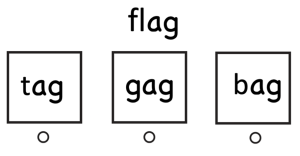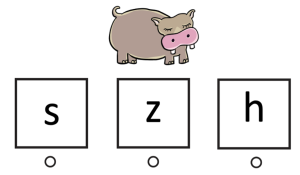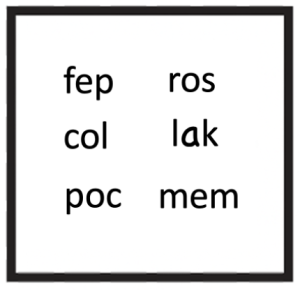CTOPP-2 – Subtests and Practice Questions
What Subtests are on the CTOPP-2?
Subtests on the CTOPP are specific tasks or activities designed to measure different aspects of phonological processing skills.
1. Elision measures the ability to delete certain sounds in words or certain parts of words such as one-half of a compound word, or the beginning, middle, or ending sound of a word. Say “baseball” without “base.” (Answer – “ball”). Say “Ditch” without saying the “d” sound. (Answer – “itch”).
2. Blending Words measures the ability to put together parts of a compound word or single sounds that make up a word. “Listen to these word parts that I’m going to say one at a time. Put the sounds together to make a whole word. /t/ /oo/ /th/” (Answer – “tooth”)
3. Sound Matching measures the ability to select pictures representing words with the same initial and final sounds. “Which word starts with the same sound as “dish”? “cup”, “duck,” or “back”? “Which word ends with the same sound as “gum”? “skin,” “fun,” or “stem”?
4. Phoneme Isolation measures the ability to identify targeted sounds in words such as the first, third, or last individual sound within a word. “What is the second sound in the word “face”? (Answer – /a/ )
5. Blending Nonwords measures the ability to synthesize sounds to form nonwords. “What word is this? “ /t/ /a/ /ck/ /u/ /p/” (Answer – “tackup”)
6. Segmenting Nonwords measures the ability to segment nonwords into phonemes. “Can you say ‘kityu’ one sound at a time”? “Can you say ‘mekint’ one sound at a time”? (Answer – “/k/ /i/ /t/ /y/ /u/”, “/m/ /e/ /k/ /i/ /n/ /t/”)
7. Memory for Digits measures the ability to repeat numbers accurately. “Repeat these numbers: 4 – 9 – 2 – 5 – 7 – 8.” (Answer – child repeats the same numbers)
8. Nonword Repetition measures the ability to repeat nonwords accurately. “Say ‘Bingette’ exactly as I say it”. (Answer – child repeats the word)
Rapid Digit and Number Naming – Here, the stimulus (numbers, letters, colors, or objects) are presented as images in rows. The child has to say the numbers, letters, colors, or objects as quickly as they can while the examiner times them.
9. Rapid Digit Naming measures the ability to rapidly name numbers.
10. Rapid Letter Naming measures the ability to rapidly name letters.
11. Rapid Color Naming measures the ability to rapidly name colors.
12. Rapid Object Naming measures the ability to rapidly name objects.
Prepare your child to excel on reading tests like the CTOPP-2, help them avoid common test-taking mistakes, and ensure a fair evaluation of their abilities. Join Testing Mom today and get 100 Free Practice Questions!
What are some Practice Questions for CTOPP-2 Skills?
Practice for Elision Questions
1. The word is “flag.” If you take the /fl/ sound in “flag” and change that to a b…b…b sound, what new word would you have?

2. The word is “teapot.” Say “teapot” but leave off “tea.”
3. The word is “spend.” Say “spend” but leave off the /sp/ sound.
Anwers: bag, pot, end
Practice for Blending Words
1. The word is “spoon” – “/s/ /p/ /oo/ /n/”. Choose the number of letter sounds you hear when you hear the word “/s/ /p/ /oo/ /n/”.

2. Listen to these letter sounds that make up a word. What word is the word I’m saying? “/m/ /a/ /th/”.
Answers: 4, Math
Practice for Sound Matching

1. Use the picture above. Choose the letter that is the last sound you hear in the picture?
2. Use the picture above. Choose the letter that is the first sound you hear in the picture?
3. The word is “goat.” Which word starts with the same sound as “goat”? “Gift”, “boat”, or “jet”?
Answers: s, h, gift
Practice for Phoneme Isolation
1. What is the third sound in the word “sand?”
2. What is the first sound in the word “phone?”
Answers: n…n…n, f…f…f
Practice for Nonword Blending and Segmenting

“Look at the words inside the box. They are silly (or nonsense) words without any meaning. Please read each word in the box to me when I say go. Ready, set, go!” (Give your child 30 seconds to read all 6 words.)
1. Say the word “bipple” exactly as I say it: “bipple”
2. Can you say the word “dunkled” one sound at a time?
Answers: bipple, /d/ /u/ /n/ /k/ /l/ /e/ /d/
Practice for Rapid Naming

“Say the name and color of each item in each row as quickly as you can without making any mistakes. For example, red car, blue apple, red bear, etc. Use your finger to keep track of your place. Put your finger on the first item. Ready, start.”
How is the CTOPP-2 Scored?
The Comprehensive Test of Phonological Processing, Second Edition (CTOPP-2), is scored using various metrics:
Age Equivalents (AE): Represents performance compared to typical age groups.
Grade Equivalents (GE): Shows performance compared to specific grade levels.
Percentile Ranks (PR): Indicates the percentage of individuals scored lower.
Subtest Scaled Scores: Scaled scores for individual subtests, with a mean of 10 and a standard deviation of 3.
Composite Indexes: Summarizes performance across related subtests.
Developmental Scores: Assess performance against developmental milestones.
Interpretation should be done by professionals for educational and intervention planning.
See if TestingMom.com supports your child’s test by your school district. If you don't see your child's school district listed, check with us! We have practice for other tests as well.



Tell us about your experiences